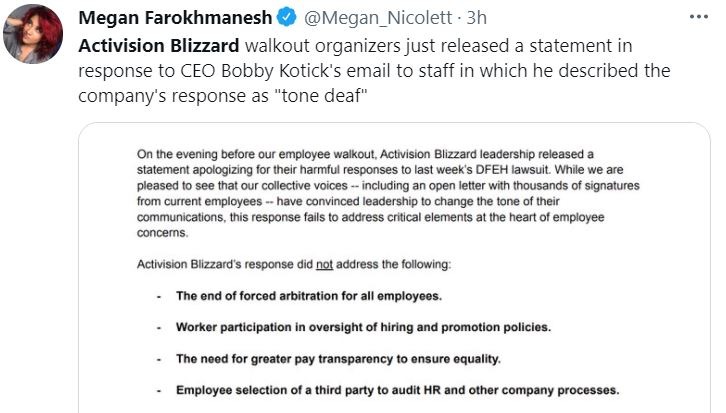What you can learn from the Activision crisis
Accusations of widespread harassment, a state lawsuit and a poor initial response prompted an employee walkout. Here’s what to take away from this cautionary workplace tale.

A worker walkout is perhaps one of the most difficult crises to manage.
It’s one thing when chaos arrives from outside sources or external circumstances. But when turmoil arises from within, internal blowups can be an extremely damaging reputational hit. Especially when the situation escalates in a very public manner.
This describes what’s unfolding at Activision Blizzard, one of the world’s largest video game makers, where employees staged a walkout Wednesday, July 28, to demand better working conditions for women following the California Department of Fair Employment and Housing’s lawsuit that alleged a “pervasive ‘frat boy’ culture” and widespread sexual harassment and discrimination. Employees listed four demands.
The #ActiBlizzWalkout 💙 is happening today because a woman was literally sexually harassed to death. Because discrimination and mistreatment against the marginalized is pervasive and the company continues to deny it. Workers have no other choice. And they have four demands. pic.twitter.com/jrAxwHN31K
— The Strix (@the_strix) July 28, 2021
The makers of World of Warcraft, Candy Crush and Call of Duty initially denied the lawsuit’s allegations, claiming it included “distorted, and in many cases false, descriptions of Blizzard’s past,” but reversed course this week after the planned walkout. CEO Bobby Kotick apologized to employees in an email, admitting the initial response was “tone deaf.” He said:
This has been a difficult and upsetting week. I want to recognize and thank all those who have come forward in the past and in recent days. I so appreciate your courage. Every voice matters—and we will do a better job of listening now, and in the future.
He said the company will work with law firm WilmerHale to review Activision’s workplace policies and procedures and outlined five steps it would take, “effective immediately:”
- Employee support. We will continue to investigate each and every claim and will not hesitate to take decisive action. To strengthen our capabilities in this area we are adding additional senior staff and other resources to both the Compliance team and the Employee Relations team.
- Listening sessions. We know many of you have inspired ideas on how to improve our culture. We will be creating safe spaces, moderated by third parties, for you to speak out and share areas for improvement.
- Personnel changes. We are immediately evaluating managers and leaders across the Company. Anyone found to have impeded the integrity of our processes for evaluating claims and imposing appropriate consequences will be terminated.
- Hiring practices. Earlier this year I sent an email requiring all hiring managers to ensure they have diverse candidate slates for all open positions. We will be adding compliance resources to ensure that our hiring managers are in fact adhering to this directive.
- In-game changes. We have heard the input from employee and player communities that some of our in-game content is inappropriate. We are removing that content.
What can communicators take away from this situation? For starters, HR expert Vadim Lieberman says this should be a wakeup call for company leaders who fail to take employee grievances seriously.
“When a situation at an organization gets to the point where employees are walking off the job, it’s clear that something has gone wrong,” he says. “Putting aside the actual grievances of Activision’s workers, this protest is a sign that Activision’s internal process for addressing serious issues seems to have failed a large number of employees. And so, when people don’t feel heard within the workplace, they will go outside of it to raise their voices.”
This is textbook case of why listening to employees is so vital. The longer you ignore complaints, the more you risk a blowup of this nature, says HR expert Tim Sackett.
“You clearly have some activist employees leading a charge to change their employment experience with Activision to something they feel is much better. You have leaders who are trying to change culture that has been in place for a long time—and has made them very successful financially. So, you get a little bit of the mentality of, ‘well, we aren’t perfect, but we aren’t that bad, really!’ That is like gasoline on the fire for an upset employee.”
Leaders should “slow down” before releasing any sort of formal internal messaging in response to incidents like this, and “listen more to the employees who are most upset,” Sackett says. Then, companies should “put together a clear of plan of action built in reality of what they are willing to do, with specific timing, and honestly what they are not willing to do.”
Sackett draws a distinction between illegal, immoral and simply undesirable behaviors, which leaders must untangle and clarify for workers to ensure everyone’s on the same page. But workers must take accountability for shaping culture, too. He says:
“There’s a difference between doing some illegal and immoral things within a culture. Those have to be stopped, immediately, and leadership team owns that. There are also some things that are just ‘hey, this is who we are’ and you might not like it, and that means you would probably be happier working someplace else. Ultimately, it’s not leaders who create, sustain and build culture. It’s the employees themselves.”
The bottom line is that “it takes time to change the typical bro-culture many of these orgs were built on,” Sackett says, adding that “the work is being done, you just have some employee who believe culture can be changed overnight, and it can’t be.”
Take a proactive approach toward reputation protection
Gerard Braud, a crisis management pro based in Louisiana, says this incident serves as a good reminder for other companies to take a more proactive tack toward episodes that could potentially damage your revenue, reputation or brand. He offers four points to bolster your defenses:
1. Every company should do regular vulnerability assessments. He advises doing so at least quarterly, but once a month is even better. “These should be meetings of the crisis communications and crisis management teams to simply evaluate what emerging issues could affect the organization’s revenue, reputation and brand,” he says.
2. When an issue is identified in a vulnerability assessment, determine if the vulnerability can be eliminated. “If you live in Tornado Alley, you can’t eliminate the vulnerability of a tornado, so you prepare your response tools,” Braud says. However, he notes that issues such as discrimination can be mitigated, prevented and, eventually, eliminated.
3. To eliminate an issue such as widespread discrimination, the organization should assemble a diverse team of employees who are keen to effect change and conduct candid conversations. Braud recommends bringing in an objective, professional facilitator to guide productive discussions. He cautions that employees might not feel free to honestly voice candid concerns if top execs are present, so leaders must make a judgment call whether their presence would help or hinder such a discussion.
4. Once the company has completed their listening activities, they have to decide on their next steps, take action, and announce what that action is. “Then comes the hard part,” Braud says, which is actually demonstrating action and showing that “real results are being achieved.”
Action, not words, is what this all comes down to. Brad Phillips from Throughline Group explains:
What the company says at this point is less important that what it hears. Their defensive statement contesting the validity of the accusations, even if partially true, misses the point that some of the accusations likely are true. Therefore, they need to send an important signal to their employees: “We hear you, we get it, and we are committed to creating a better, fairer, and safer company culture.” Then, they should pair those words with actions by pledging to hire a third party to investigate the accusations, taking disciplinary action (including termination) where necessary (including at the executive level), and releasing the key findings publicly.”
How about you, Ragan readers? What steps would you take if you were in Activision’s position?
(Image via)








You may surprise and please your management and workers alike by making your own demands on behalf of workers. Tell WHY they deserve better than the strike, HOW the company proposes to assure them the better deal workers deserve, and WHEN—really soon—you hope workers and management alike will get back to getting what’s best for them by everyone doing what’s best for the public.
Skilled PR can sometimes help workers see the truth that conflict of
Interest may NOT be so much between management and labor both of which may benefit by ending the disagreement but between activists looking to promote the disturbance advance themselves rather than looking to end it.
The big question workers have, and it’s certainly reasonable, is “what will we get?” PR can help everyone see answers that are not only short term but longer term. “This should and will end,” you can say, and your PR can help make that happen sooner.
By helping spotlight important truths about everyone’s future, you can help create a better future for everyone including yourself. Start by thinking of what you can demand on the part of your deserving workers many of whom would rather not be out.